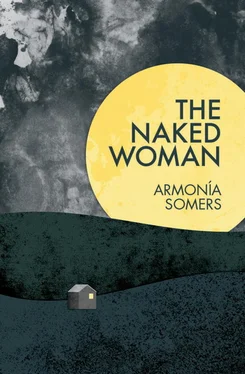Armonía Somers - The Naked Woman
Здесь есть возможность читать онлайн «Armonía Somers - The Naked Woman» весь текст электронной книги совершенно бесплатно (целиком полную версию без сокращений). В некоторых случаях можно слушать аудио, скачать через торрент в формате fb2 и присутствует краткое содержание. Город: New York, Год выпуска: 2018, ISBN: 2018, Издательство: The Feminist Press, Жанр: Современная проза, на английском языке. Описание произведения, (предисловие) а так же отзывы посетителей доступны на портале библиотеки ЛибКат.
- Название:The Naked Woman
- Автор:
- Издательство:The Feminist Press
- Жанр:
- Год:2018
- Город:New York
- ISBN:978-1-93-693-244-3
- Рейтинг книги:5 / 5. Голосов: 1
-
Избранное:Добавить в избранное
- Отзывы:
-
Ваша оценка:
- 100
- 1
- 2
- 3
- 4
- 5
The Naked Woman: краткое содержание, описание и аннотация
Предлагаем к чтению аннотацию, описание, краткое содержание или предисловие (зависит от того, что написал сам автор книги «The Naked Woman»). Если вы не нашли необходимую информацию о книге — напишите в комментариях, мы постараемся отыскать её.
The Naked Woman — читать онлайн бесплатно полную книгу (весь текст) целиком
Ниже представлен текст книги, разбитый по страницам. Система сохранения места последней прочитанной страницы, позволяет с удобством читать онлайн бесплатно книгу «The Naked Woman», без необходимости каждый раз заново искать на чём Вы остановились. Поставьте закладку, и сможете в любой момент перейти на страницу, на которой закончили чтение.
Интервал:
Закладка:
Rebeca Linke’s personal journey demands the suspension of any rational skepticism and the acceptance of the uncanny mise-en-scène in which Somers’s characters are situated. This entails an ethical awareness, according to which women’s bodies and sexuality will be treated from a particular point of view: “I don’t overlook these topics [of love and eroticism]; rather, I face them head on. I attempt an aseptic approach, not a celebratory one,” Somers explains. [17] Gandolfo (translation my own). “Es decir que no miro al sesgo el tema, sino de frente. Lo que procuro es el tratamiento aséptico, no el regodeo.”
Early on in the novel, the aseptic narrator describes a woman’s brutal rape by her husband in which he dismisses his wife’s body completely: “He was oblivious to everything else, even the inert, pale, suffering body he was assaulting” (18). The Naked Woman’s experience is recounted differently: “The woman left the cabin behind without ever turning back, not even to check if it had been real. She wasn’t about to wallow in her failure. She had been a guest there and had wanted, demanded even, something they didn’t know how to give her” (21). The starkness of this affective and aesthetic approach to narrative, even in scenes of extreme violence, demands that readers question preconceived notions and expectations and reorient themselves with regard to the text. Moreover, Somers’s writing requires that we read with and examine a sense of humor and irony, while questioning social taboos, moral values regarding sexuality, religious beliefs, and modern scientific discourse on civilization. For instance, the description of the Naked Woman’s beauty, as seen through other characters’ eyes and desires, reinforces her otherness while peppering the text with sarcasm:
They made their grand discovery: a naked woman in the middle of the field! They sat stock-still, their necks stretched out as far as they could go. It wasn’t a ghost or a tree, but a real woman with long, loose hair and arms down at her sides… a wonderful woman such as this springing up from the earth, or appearing in the bathroom, or in the window across the road, offering herself in apparent supplication… (28)
The sarcastic tone, with its overblown grandiosity, makes us consider just how women’s bodies are socially constructed and viewed.
Satire and sarcasm pervade the text, providing both humor and biting criticism. The target may be conventionality in any form: historical, social, cultural, and therefore aesthetic, too. In an interview conducted in 1978 by scholar Evelyn Picon Garfield, Somers points out how this strategy was essential when addressing commonly accepted beliefs: “You see, in me there is such a kind of religiosity I try to transform into irreverence, so much so that in my latest novel Solo los elefantes encuentran mandrágora , I call God an atheist.” [18] Picon Garfield, 42.
It is with similar irreverence that The Naked Woman effectively undertakes the deconstruction of traditional feminine archetypes, often themselves imbued with religious symbolism.
While these archetypes are dismantled in the novel, it is worth noting another key feminine figure, specific to Río de la Plata colonial history. Since the early nineteenth century, when Argentina and Uruguay were still taking shape as independent nations, tales of captive women emerged in the cultural imagination through literature and, especially, art. Such is the case in the work of Uruguayan nineteenth-century artist Juan Manuel Blanes, whose painting La cautiva (1880) depicts white women taken captive by indigenous men in las pampas —literally grasslands, but frequently figured as empty land and as a sort of frontier between civilization and barbarism. The rescue of the captive woman came to signify the rescue of progress and civilization. As scholar Christopher Conway observes, a binary opposition between civilization and barbarism
was omnipresent throughout nineteenth-century literature and journalism as a justification for celebrating the modernizing (and Europeanized) agenda of liberalism and for denigrating cultural actors and elements associated with rural life and the colonial past. [19] Conway 2015, 117.
But counternarratives also existed, opposing the widespread idea of las pampas as an empty space and of women as passive agents. A well-known example among Argentine literature is La cautiva (1837), a Romantic poem written by author Esteban Echeverría. In this poem, María, a captive woman, and Brian, a Christian soldier, fall in love in the midst of las pampas while fighting against Indians. Brian is wounded while María tries to defend herself. She manages to fight off the Indians with a small dagger and escape, and, in the Romantic tradition, Brian dies in María’s arms on the shores of the river. Both the nineteenth-century poem and Somers’s avant-garde novel are laden with Romantic symbolism, where, for instance, the light of day and the dark of night become clear symbols of good and evil. They even share a similar ending. But Somers goes further by fundamentally questioning who, in fact, the “uncivilized” are when persecuting the Naked Woman.
Soon the barbarian army was fully assembled. It seemed very important that they head out on their expedition en masse. Although the bounty would ultimately be individual, or at least impossible to divvy up, a sense of victory could still be shared and the presence of so many men served as justification in itself: they were a united front. (34)
The barbarians, suggests the narrator, are actually those Christians from whom the Naked Woman tries to escape. Unlike Echeverría’s heroine, Rebeca Linke journeys from a so-called civilized Christian life to a new alleged freedom in nature. When she encounters civilization again after leaving her cabin—represented by the villagers, the church, the priest, and the town itself—she is fiercely persecuted.
This tale of reverse captivity is a nod to Latin America’s colonial history, and shows how categories such as civilization and barbarism are contingent on who is telling the story. However, Somers was not the only writer who addressed a counter-narrative. In 1949 Jorge Luis Borges published El Aleph , which included a short story entitled “Historia del guerrero y la cautiva,” in which an English woman voluntarily joins the indigenous people from las pampas. But Somers took it further, as she was the only one who subtly addressed this reversed captivity tale in her novel by telling the story from a woman’s perspective.
In addition to speaking to cultural and historical shifts across Latin America, The Naked Woman can be read as an early symbol of Uruguay’s transformation into an open-minded and egalitarian society through the acceptance of women’s subversive writing in the mainstream literary arena. Even early critics of Somers’s work, who maintained that she was not political because her stylistic choices did not conform to naturalism, later corrected themselves and acknowledged the subtle layers of social satire present in her writing. As a matter of fact, critic Ángel Rama became Somers’s first editor, promoting her novels and short stories abroad.

Armonía Somers’s life and writing were as inspiring in the fifties as they are now. She embodied everything a woman writer wants and simultaneously fears to be: innovative, rebellious, talented, and, moreover, free from the strictures of the masculine literary realm. Somers battled critics, reviewers, journalists, and the academic and scholarly demands of institutions, and finally succeeded at writing and publishing on her own terms. Renowned Uruguayan critic Rómulo Cosse claimed that the renaissance in Uruguayan literature was possible thanks to Armonía Somers. [20] Cosse 1988.
Certainly, Somers shook the literary scene. Despite circumstances having changed since 1950, The Naked Woman is still a critical and creative call for resistance against the essentialization of women’s experiences.
Интервал:
Закладка:
Похожие книги на «The Naked Woman»
Представляем Вашему вниманию похожие книги на «The Naked Woman» списком для выбора. Мы отобрали схожую по названию и смыслу литературу в надежде предоставить читателям больше вариантов отыскать новые, интересные, ещё непрочитанные произведения.
Обсуждение, отзывы о книге «The Naked Woman» и просто собственные мнения читателей. Оставьте ваши комментарии, напишите, что Вы думаете о произведении, его смысле или главных героях. Укажите что конкретно понравилось, а что нет, и почему Вы так считаете.











